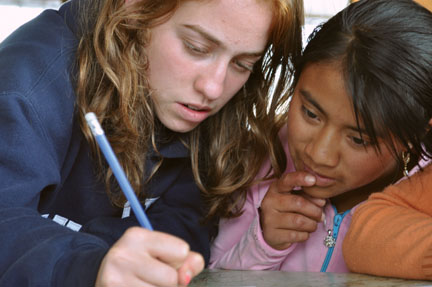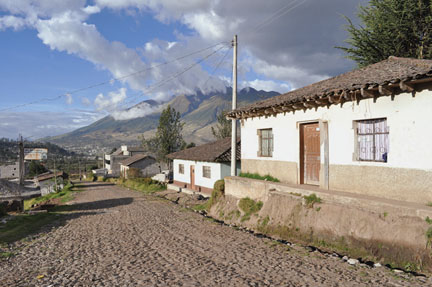Breaking Down Barriers
In Ecuador’s highlands, an education project aims to “create a new fluidity and class mobility,” says founder Katie Chamblee ’07.

UPenn student Becca Rosen ’12 (left) teaches a young Ecuadorean girl as a participant in the Village Education Project, founded in 2005 by Katie Chamblee ’07.
The Village Education Project was built on a simple premise. “What we’re sponsoring is the opportunity to go to high school,” says Kendal Rinko ’09, the nonprofit’s young director of development.
Founded in 2005 by Katie Chamblee ’07, the Village Education Project (VEP) covers the costs of a high school education, on average about $200 per year, for students from six Ecuadorean villages. Here, in the largely indigenous villages outside Otavalo—a colorful market town about 50 miles north of Quito that is frequented by tourists—schools cling to the sides of mountains. Against the soft green creases of the Andes, snow-capped Volcán Cayambe looms. Here, fathers work mainly as day laborers, farming the surrounding haciendas; large families live on little.
Here, “Our work focuses not on creating new opportunities but on eliminating the barriers that exist already in Ecuador,” Chamblee explains in an essay for the online magazine Policy Innovations. “Using the villages, schools, and curricula that are already in place, we create a new fluidity and class mobility.”
Chamblee started the VEP while at Swarthmore, after a summer volunteering in Ecuador through Global Vision International. Her then-host father, Gilberto Cifuentes—a school principal and fellow founder—manages the program’s in-country operations; a volunteer staff of Swarthmore students handles tasks like fundraising and recruiting volunteers; and Chamblee, now a first-year student at Yale Law School, serves as a liaison between the two. “It’s challenging. I’m working with two staffs that I rarely see, one in Swarthmore and another in Ecuador,” Chamblee says in an interview.

The Project helps provide children from six Ecuadorean villages not far from Otavalo—a market town 50 miles from Quito—with the opportunity to attend high school.
The project also employs a year-round tutor to support the students on scholarship. Despite the virtual way it does business, the VEP is, indeed, based on a village-wide or community-wide ethos. Its stated mission is “to empower underprivileged villages in Ecuador by making education an accessible and sustainable resource in community life.” Scholarships covering matriculation fees, books, and uniforms through the six years of secondary school are available to any and all students from the six villages under the project’s sponsorship.
In order to qualify for scholarships, students must pass an intensive summer course in math and English, taught mainly by American volunteers. “It’s not really that hard to pass the course. We make the course a prerequisite because we don’t want to send people on who are under-prepared. We want our students to do well,” Chamblee explains.
“As [summer] program coordinator, I have the privilege of dealing with parents. The first few weeks were somewhat overwhelming in that respect. We had lines of parents at the office with questions about the program and wondering if their child could enroll,” says Juan Victor Fajardo ’09, who managed this summer’s program after graduating with a major in philosophy and a minor in Latin American Studies. “Parenthood in rural, indigenous communities is nothing like parenthood in the city or in the ‘western’ world. The people who inhabit this part of the world have a unique and millenary connection with the land. It manifests itself not only in their history, in the way they look, in their language and identity, but also in their livelihoods. When a young child is old enough to work in the field or at home, that’s exactly what they do.
“In the past months, however, I have met parents that are legitimately interested in their son or daughter’s education. They understand that the cost of having their child at home working instead of at school is something no one can afford, no matter where you’re from. I specifically remember one conversation I had with a father who was in his early thirties. He had come to check up on his daughter to find out how she was doing. His daughter is one of the best students at one of the schools and that was not surprising at all. It became obvious to me that part of the reason why she was doing so well was because of the support she was receiving at home. Her dream of going to high school was one that she shared with her whole family. After our conversation was over, I remember thinking, ‘This is exactly why I took this job.’” Fajardo says.
“The motivated students were very motivated,” says Anna Phillips ’09, who taught in summer 2008 at a school called Mojandita, in the village of Mojanda, a 15-minute drive from Otavalo. “It feels much further away, because it’s a 15-minute drive straight up the side of a mountain,” says Phillips.
Phillips remembers the case of a 15-year-old student: “He was the oldest by far of the students we were teaching, who were mostly 10- to 13-year-olds. Even though he lacked the academic skills of most of the students—and he really wanted to be the cool older one—he realized this was his last chance at an education. This is a huge motivator for these kids. A lot of them want to be able to provide more for their families. They want to live somewhere with running water.”
In addition to teaching, Phillips—a physics major at Swarthmore with minors in education and math—carved out a role as curriculum developer for the VEP, traveling to Ecuador on a separate visit to interview educators about the skills students lacked and would most need in high school. “Until last summer, volunteers had just been making it up as they went. I didn’t want to let that happen anymore,” Phillips says.
The summer English curriculum starts from scratch—“with the alphabet, hello, my name is, can I do that, door, pencil—absolute basics,” Phillips says. The summer math curriculum begins with fractions and decimals, shifts to geometry and basic shapes, and ends with negative numbers. “These things are conceptually difficult. It’s really important that they see them and at least get comfortable with them, even if they don’t completely understand them before they get to high school,” Phillips says.
Of her own students’ readiness for secondary school at summer’s end, Phillips continues, “I knew it would be hard for some students, and I actually told them that I think it’s going to be very hard for you to be in high school, but if you get help—we provide a year-round tutor for the students—and you work hard, you can do it. There were also students who I knew would be fine, the ones who got 20 out of 20 on every quiz in the summer program. On the whole, I think that most students were ready for the challenge, even if they weren’t as academically ready as they would be in an ideal world.”
“My role as a curriculum developer,” Phillips adds, “has focused on making the service we provide to the kids as valuable as it can be and on making the project a sustainable one that improves every year. I’m really convinced that there’s a forward momentum now.”
The momentum has been propelled in part by a three-year, $25,000 grant from the Swarthmore College Project Pericles Fund. Eugene Lang ‘38 and the Board of Managers created the fund in 2005 to provide support for social and civic action projects of substantial scope that are designed and implemented by groups of Swarthmore students.
In addition to formalizing its summer curriculum, the VEP has increased the number of villages under its sponsorship, from four to six, and the number of scholarships awarded, from 48 in 2006–2007 to an estimated 150 in the current school year. The project is also contemplating building a high school of its own—that is, the villages’ own. As of now, the students walk up to an hour from their rural villages to attend one of five colegios in Otavalo.
“We still have a lot of details to work out, but our idea is that the children who we sponsor to go to high school, instead of going to different schools all over Otavalo, will go to our school and stay together for three years. This will make it a lot easier for us to keep track of our kids’ progress and will centralize our support of them,” says Amber Wantman ’10, who researched the cost of building a school while volunteering as a teacher this summer.
“I think we’re really ready to do it,” Chamblee says, reflecting on the growth of the organization.
“You have to show people that you’re working with what already exists. You’re not out to change the community, and when you do make changes, you want to do them very incrementally. You want to grow at a rate that can be incorporated into a community. We started with a few kids, and now people know that those kids have successfully gone on to high school.”
With many development organizations focused on scaling up, Chamblee believes that VEP should instead focus on scaling in, building on the existing program and exploring how to improve it.”
Elizabeth Redden ’05, a former reporter with Inside Higher Ed in Washington, D.C., studied abroad in Ecuador while at Swarthmore. She is currently in the first year of Columbia University’s MFA program in nonfiction writing.
 Juan Víctor Fajardo ’09, a native of Caracas, Venezuela, majored in philosophy and minored in Latin American studies. While at Swarthmore, he studied photography with Jessica Todd Harper and Ron Tarver. He spent the summer in Ecuador, where he worked as program coordinator and photographer for the Village Education Project, and is currently in Caracas preparing applications for graduate school in investigative journalism.
Juan Víctor Fajardo ’09, a native of Caracas, Venezuela, majored in philosophy and minored in Latin American studies. While at Swarthmore, he studied photography with Jessica Todd Harper and Ron Tarver. He spent the summer in Ecuador, where he worked as program coordinator and photographer for the Village Education Project, and is currently in Caracas preparing applications for graduate school in investigative journalism.
 Email This Page
Email This Page





January 4th, 2011 10:53 pm
This is a great organization. I have a friend that volunteered for a similar charity and she said it was one of the most rewarding experiences of her life.